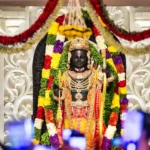Ayodhya Shri Ram Mandir: A Catalyst for Tourism and Economic Growth
The Ayodhya Shri Ram Mandir, beyond its spiritual and religious significance, has emerged as a major catalyst for tourism and economic development in the region. This temple in Ayodhya is not just a pilgrimage destination but a magnet for tourists and history enthusiasts from around the world.
Boosting Tourism in Ayodhya with the Shri Ram Mandir
The construction of the Ayodhya Shri Ram Mandir has significantly increased the city’s appeal as a tourist destination. The temple, with its grandeur and historical significance, draws pilgrims and tourists alike, eager to witness its beauty and soak in its spiritual aura. This influx of visitors has led to a flourishing tourism industry in Ayodhya, with hotels, guesthouses, and eateries catering to the needs of the visitors.
Economic Impact of Ayodhya Shri Ram Mandir on the Local Community
The rise in tourism due to the Ayodhya Shri Ram Mandir has had a positive impact on the local economy. Businesses related to hospitality, travel, and services have seen growth, providing employment opportunities and boosting the local market. The government’s initiatives to improve infrastructure and promote Ayodhya as a major tourist spot further contribute to this economic upswing.
Government Initiatives and Infrastructure Development
In response to the growing popularity of the Ayodhya Shri Ram Mandir, the government has undertaken several initiatives to enhance the city’s infrastructure. These initiatives aim to support the increasing number of visitors and improve the overall experience for pilgrims and tourists.
Improved roads, better facilities, and enhanced public services are part of these development plans, ensuring that Ayodhya can accommodate its visitors comfortably and efficiently.
The Ayodhya Shri Ram Mandir as a Symbol of Cultural Tourism
The Ayodhya Shri Ram Mandir is more than a religious site; it’s a symbol of India’s rich cultural heritage. Visitors to the temple can immerse themselves in the stories and teachings of the Ramayana, gaining insights into Hindu traditions and beliefs.

This cultural aspect of the temple makes it an attractive destination for those interested in exploring India’s religious and historical roots.
In summary, the Ayodhya Shri Ram Mandir has become a key driver of tourism and economic development in Ayodhya. Its construction not only fulfils a spiritual purpose but also plays a significant role in enhancing the city’s cultural and economic landscape.
Ayodhya Shri Ram Mandir: Fostering Religious Harmony and Social Unity
The Ayodhya Shri Ram Mandir, while deeply rooted in Hinduism, plays a significant role in promoting interfaith understanding and social unity. This revered temple in Ayodhya symbolizes more than just religious devotion; it represents an opportunity for fostering mutual respect and unity among different communities.
The Role of Ayodhya Shri Ram Mandir in Hindu Society
The Ayodhya Shri Ram Mandir resonates profoundly within Hindu society, serving as a symbol of unity, reverence, and spiritual connection among devotees. It stands as a testament to the community’s commitment to preserving its cultural and religious heritage. The temple’s construction and the devotion it inspires have strengthened the bonds within the Hindu community, creating a sense of shared identity and collective pride.
Beyond Hinduism: Ayodhya Shri Ram Mandir and Interfaith Relations
The significance of the Ayodhya Shri Ram Mandir extends beyond Hinduism, presenting opportunities for interfaith dialogue and harmony. The temple’s construction, while a deeply Hindu endeavour, also signifies a broader cultural and historical narrative that people of all faiths can appreciate. It offers a platform for different religious communities to engage in conversations about shared values, mutual respect, and understanding.
Ayodhya Shri Ram Mandir as a Symbol of Inclusivity
In the contemporary context, the Ayodhya Shri Ram Mandir symbolizes the possibility of inclusivity and pluralism within the framework of religious and cultural diversity. By respecting the beliefs and sentiments of different communities, the temple can be a beacon for peace and unity in a diverse society.
Promoting Cultural Understanding Through Ayodhya Shri Ram Mandir
The Ayodhya Shri Ram Mandir also plays a crucial role in educating and enlightening people about Hindu traditions and cultural narratives. Through this understanding, individuals from different faiths can appreciate the rich tapestry of Indian religious history, leading to greater cultural empathy and respect.

In conclusion, the Ayodhya Shri Ram Mandir stands not just as a religious structure but as a symbol of hope for unity and understanding in a diverse world. Its presence in Ayodhya is a reminder of the potential for religious sites to bridge gaps between communities and foster a spirit of togetherness and mutual respect.
Ayodhya Shri Ram Mandir: Celebrating Festivals and Cultural Traditions
The Ayodhya Shri Ram Mandir, a symbol of faith and devotion in Hinduism, plays a pivotal role in the celebration of religious festivals and cultural events. This temple in Ayodhya not only serves as a spiritual centre but also as a hub for cultural vibrancy, drawing devotees and visitors to partake in various festivities.
Festivals at Ayodhya Shri Ram Mandir
The Ayodhya Shri Ram Mandir is the epicentre of numerous Hindu festivals, each carrying deep spiritual and cultural significance. These festivals reflect the rich tapestry of Hindu mythology and traditions, offering a glimpse into the diverse rituals and practices of the faith.
One of the most significant festivals celebrated at the Ayodhya Shri Ram Mandir is Diwali, the festival of lights. Diwali holds special importance in Ayodhya, as it commemorates the return of Lord Ram to Ayodhya after his victory over Ravana, as narrated in the Ramayana. The temple and the city are illuminated with lights and earthen lamps, symbolizing the triumph of good over evil and light over darkness.
Cultural Significance of Festivals in Ayodhya
The festivals celebrated at the Ayodhya Shri Ram Mandir are not just religious ceremonies; they are a vibrant expression of Indian culture and heritage. These events bring together people from diverse backgrounds, fostering a sense of community and shared joy. The temple serves as a venue for various cultural activities, including music, dance, and theatrical performances based on Hindu epics and stories.
Impact of Festivals on Community and Tourism
The celebration of festivals at the Ayodhya Shri Ram Mandir significantly impacts the local community and tourism. These events attract thousands of pilgrims and tourists, boosting the local economy and providing opportunities for cultural exchange.

The influx of visitors during festival times creates a lively and festive atmosphere in Ayodhya, further enhancing the city’s appeal as a tourist destination.
Ayodhya Shri Ram Mandir: A Beacon of Hindu Traditions
In summary, the Ayodhya Shri Ram Mandir is more than just a place of worship; it is a beacon of Hindu traditions and cultural celebrations. The festivals held at the temple are a testament to the enduring legacy of Hindu mythology and the unifying power of shared cultural experiences.
Ayodhya Shri Ram Mandir: Unveiling Ayodhya’s Rich Heritage and Attractions
The Ayodhya Shri Ram Mandir, beyond its spiritual significance, acts as a gateway to exploring the rich heritage and myriad attractions of Ayodhya. This temple in Ayodhya is not just a religious landmark but also a starting point for visitors to immerse themselves in the city’s profound historical and cultural legacy.
Exploring Ayodhya’s Heritage Through Shri Ram Mandir
The Ayodhya Shri Ram Mandir offers a unique perspective on the city’s history and mythology. Visitors to the temple can learn about Ayodhya’s significance as the birthplace of Lord Ram and its central role in the epic Ramayana. The temple, with its intricate architecture and religious importance, provides insights into the city’s ancient past and its ongoing cultural relevance.
Ayodhya’s landscape is dotted with numerous other temples, ghats (riverfront steps), and historical sites, each with its own story. The city’s heritage is closely tied to the Ramayana, and many locations within Ayodhya are associated with events from the epic. The temple serves as a focal point for visitors to begin their exploration of these significant sites.
Cultural and Historical Significance of Ayodhya
Ayodhya is not just about religious significance; it’s a city with a deep cultural and historical identity. The Ayodhya Shri Ram Mandir plays a pivotal role in showcasing this identity. The city’s traditions, art forms, and festivals are all deeply influenced by its mythological and historical background, making it a rich tapestry of cultural experiences.
The city’s ghats along the Sarayu River, the Kanak Bhawan, and the Hanuman Garhi are among the other notable attractions that offer a deeper understanding of Ayodhya’s spiritual and cultural fabric. These places, together with the Ayodhya Shri Ram Mandir, form an integral part of the city’s identity, drawing visitors into a world where mythology and history converge.
Ayodhya as a Pilgrimage and Tourist Destination
With the Ayodhya Shri Ram Mandir as its centrepiece, Ayodhya has become an increasingly popular destination for both pilgrims and tourists. The city offers a blend of spiritual tranquillity and historical exploration, making it an appealing destination for a wide range of visitors. The temple’s presence has further elevated Ayodhya’s status, attracting people interested in spirituality, history, and culture.

In summary, the Ayodhya Shri Ram Mandir is more than a temple; it is a portal to the ancient city of Ayodhya, rich in mythological and historical narratives. It invites visitors to explore beyond its boundaries, to discover the city’s heritage, and to experience its cultural depth.
Conclusion: The Ayodhya Shri Ram Mandir – A Symbol of Faith and Future Aspirations
As we conclude our exploration, the Ayodhya Shri Ram Mandir emerges not merely as a testament to the past, but as a beacon guiding the spiritual and cultural aspirations of future generations. This temple in Ayodhya stands as a living embodiment of the confluence of faith, history, and architectural brilliance.
The Ayodhya Shri Ram Mandir: A Bridge Between Eras
The construction of the Ayodhya Shri Ram Mandir marks a significant moment in the preservation and celebration of Hindu cultural heritage. It represents the culmination of years of dedication and faith, echoing the aspirations and devotional spirit of millions. The temple serves as a bridge between the ancient history of Hinduism and its present and future, embodying the continuity of cultural and religious traditions.
The Temple’s Role in Shaping Ayodhya’s Future
Looking ahead, the Ayodhya Shri Ram Mandir is poised to play a crucial role in shaping the future of Ayodhya. With its completion, the temple is expected to attract an even greater number of visitors, further enhancing the city’s status as a major cultural and spiritual hub. This influx will likely spur further development in the area, including infrastructure improvements and cultural initiatives, thus fostering economic growth and cultural enrichment.
The Global Impact of the Ayodhya Shri Ram Mandir
The Ayodhya Shri Ram Mandir transcends geographical boundaries, drawing attention from around the world. It stands as a symbol of the global presence and influence of Hindu culture and spirituality. The temple’s story, steeped in history and mythology, offers a narrative that resonates with people across different cultures and backgrounds, promoting a deeper understanding of Hindu traditions and values.
Embracing the Future with Tradition
The Ayodhya Shri Ram Mandir is more than a religious landmark; it is a symbol of the harmonious blending of tradition with modern aspirations. As the temple nears its completion, it invites believers, enthusiasts, and the curious alike to witness its story, where each element tells a tale steeped in spiritual heritage and cultural resonance.

In conclusion, the Ayodhya Shri Ram Mandir stands as a powerful symbol of faith, unity, and cultural pride, beckoning a future where tradition and progress walk hand in hand. As the temple opens its doors, it will not only be a place of worship but a testament to the enduring spirit of devotion and the unyielding strength of cultural identity.

































